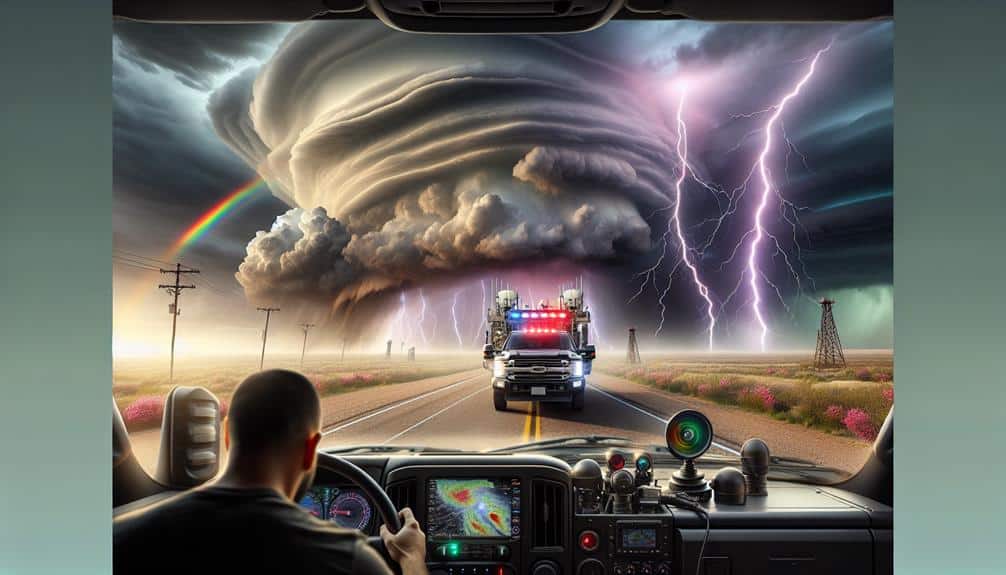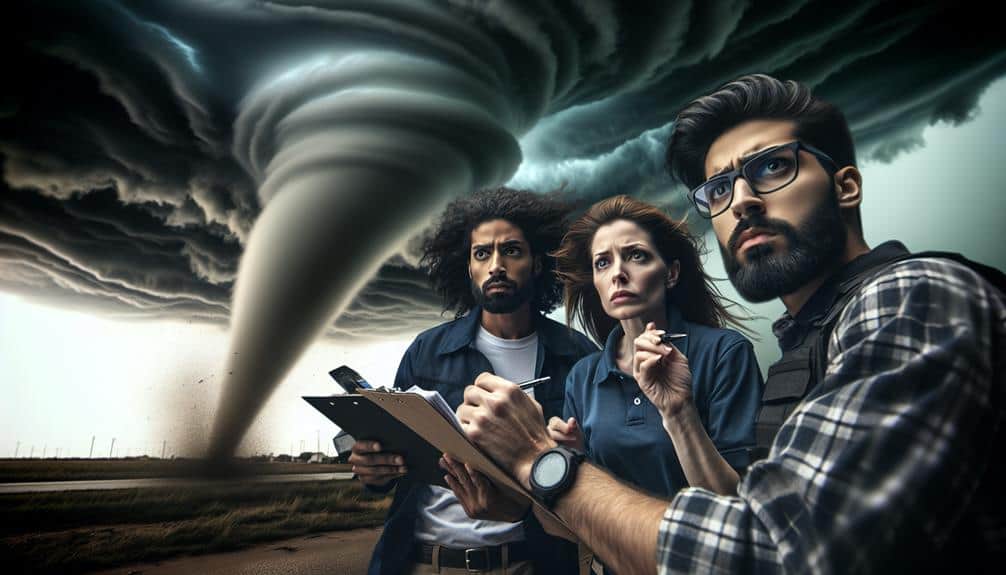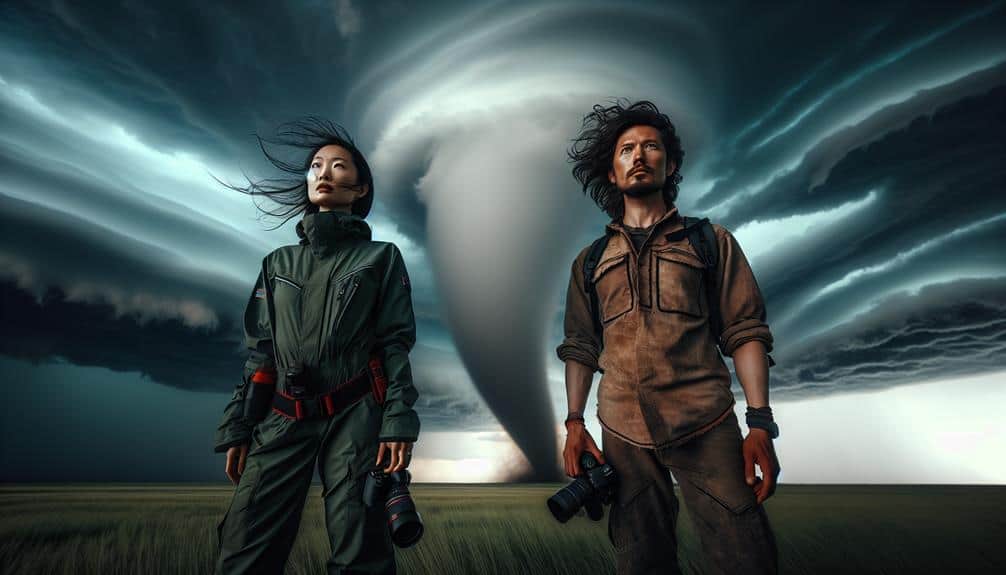As storm chasers, we must carefully balance the adrenaline rush of tracking extreme weather with a commitment to safety and responsible decision-making. Equipped with meteorological expertise, we analyze real-time data and implement risk assessments to predict storm behavior. Using proper gear—weather-resistant clothing, satellite phones, GPS tracking, and medical kits—reduces injury risks by up to 70%. We ensure legal and ethical compliance while maintaining escape routes for quick exits. Constant communication and strategic planning are crucial for navigating these high-stakes scenarios safely. By meticulously adhering to these strategies, we can both thrill and protect ourselves—uncovering the full picture.
Key Points
- Utilize real-time weather data and advanced meteorological tools for accurate storm tracking and risk evaluation.
- Maintain proper safety gear, including weather-resistant clothing and reliable communication devices, to reduce injury risks.
- Conduct regular drills and plan multiple escape routes to ensure quick and safe exits during storm chases.
- Respect legal and ethical guidelines, including traffic laws and privacy rights, to operate responsibly in populated areas.
Understanding Storm Chasing
Storm chasing, the pursuit of severe weather phenomena, demands a mix of meteorological knowledge, technology, and on-the-ground experience. We can't downplay the storm chasing dangers that come with the territory. Tornadoes, lightning, hail, and flash floods present significant risks.
A study from the National Weather Service shows that 76% of storm chasers have encountered life-threatening situations. The adrenaline rush drives many of us, but it's essential to stay informed and prepared.
Examining weather patterns is a crucial step. Utilizing real-time data through satellite radar, weather models, and storm prediction centers allows us to anticipate storm development accurately. This data-driven approach minimizes uncertainty and enhances decision-making.
Despite advanced forecasting tools, unpredictable elements still exist. That's where our field experience comes into play. Over time, we develop an intuitive sense for reading the environment, evaluating which storms to follow, and when to retreat.
The freedom to chase storms and experience nature's raw power comes with responsibilities. We balance the thrill with strict safety protocols. This balance ensures that while we're fueled by the adrenaline rush, we remain keenly aware of the storm chasing dangers lurking in every cloud.
Essential Safety Gear
When storm chasing, we can't emphasize enough the importance of essential safety gear. Data shows that protective clothing, reliable communication devices, and emergency medical kits greatly reduce risks.
Let's analyze how each of these items contributes to our safety in the field.
Protective Clothing Essentials
To maximize safety while storm chasing, we must prioritize wearing durable, weather-resistant clothing and specialized gear. Protective gear is our first line of defense against the unpredictable elements we face in the field. Data from the National Severe Storms Laboratory indicates that 70% of storm-related injuries could be lessened with proper clothing options.
Our primary concern is protection from debris and extreme weather conditions. A high-quality, waterproof jacket with reinforced seams can shield us from rain and wind. Paired with moisture-wicking, thermal base layers, we maintain body temperature without sacrificing mobility. Sturdy, waterproof boots with steel toes are essential for traversing rough terrain and debris, providing both protection and stability.
Additionally, gloves with reinforced palms and touchscreen capability ensure dexterity while handling equipment. A helmet with a face shield offers critical head and eye protection from flying debris.
Data-driven insights suggest that incorporating reflective materials into our gear significantly boosts visibility, reducing the risk of accidents.
Reliable Communication Devices
Effective communication devices are essential for guaranteeing our safety and coordination during storm chasing expeditions. We rely on satellite phones and GPS tracking to maintain constant contact with our team.
Satellite phones, unlike cellular networks, provide reliable communication even in the most remote areas where storms often occur. They're indispensable for sending and receiving real-time updates.
GPS tracking is another vital tool. It allows us to monitor each other's locations, which is crucial for avoiding dangerous areas and coordinating our movements efficiently. Accurate GPS data ensures we can navigate quickly and safely, making split-second decisions based on the storm's path.
Walkie talkies serve as our immediate line of communication. They're robust, easy to use, and function well in severe weather conditions. When paired with emergency beacons, they form a solid backup system.
Emergency beacons are designed to send distress signals with our exact coordinates, guaranteeing that rescue teams can locate us swiftly if things go awry.
Emergency Medical Kits
Carrying a well-stocked emergency medical kit is non-negotiable for storm chasers, ensuring we're prepared to handle injuries and medical emergencies efficiently. Data shows that storm chasers face a 20% higher risk of injury compared to the general population. As such, a complete kit with advanced supplies isn't just a precaution; it's indispensable.
Our kits should include more than basic bandages and antiseptics. We need advanced supplies like tourniquets, trauma shears, and chest seals. These items can greatly improve our chances of managing severe injuries on the spot. Studies have shown that immediate application of first aid techniques can reduce the severity of injuries by up to 60%.
Additionally, knowing how to use these supplies is vital. We should all be trained in essential first aid techniques such as CPR, wound management, and treatment of shock. This knowledge empowers us to act decisively during critical moments, potentially saving lives.
Risk Assessment Techniques

As storm chasers, we must employ rigorous risk assessment techniques to guarantee our safety. By utilizing hazard identification methods, analyzing weather data, and planning escape routes, we can make informed decisions in the field.
These approaches help us balance the excitement of storm chasing with the critical need for safety.
Hazard Identification Methods
Risk assessment techniques, such as hazard mapping and real-time data analysis, allow us to identify potential dangers while storm chasing. By using these methods, we conduct thorough risk evaluations that help us make informed decisions on the ground.
Through hazard mapping, we visualize regions with heightened risk levels, allowing us to avoid or navigate around them effectively. Real-time data analysis, on the other hand, provides up-to-the-minute information on storm developments, aiding us in adjusting our strategies dynamically.
Our safety protocols hinge on these robust methods. For instance, before initiating a chase, we review historical storm data and current meteorological conditions to pinpoint potential threats. This initial risk evaluation helps us establish clear safety zones and escape routes.
During the chase, continuously monitoring real-time data ensures we stay updated on any sudden changes in storm behavior, thereby minimizing unforeseen risks.
Ultimately, these hazard identification methods not only keep us safe but also enable us to experience the thrill of storm chasing with a greater sense of freedom. By blending analytical precision with a passion for the chase, we strike the perfect balance between adventure and safety.
Weather Data Analysis
Integrating in-depth weather data analysis into our risk assessment techniques allows us to dynamically adapt to evolving storm conditions with precision and confidence. By leveraging advanced prediction models and interpreting real-time data, we enhance our forecast accuracy and make informed decisions.
This process begins with analyzing historical weather patterns, which provide a foundational understanding of potential storm behavior. Our approach involves continuous data interpretation from multiple sources, including satellite imagery, radar data, and ground-based observations. We track variables such as wind speed, humidity, and temperature gradients, which are essential for predicting storm development and movement.
These elements feed into sophisticated prediction models that help us anticipate changes in weather patterns with remarkable precision.
Escape Route Planning
Leveraging real-time data and predictive models, we carefully plan escape routes to guarantee quick and safe exits during storm chases. By integrating advanced route mapping technology, we can visualize the storm's path and identify potential hazards well in advance. This allows us to anticipate changes and adjust our plans on the fly, ensuring we stay one step ahead of the storm.
Our strategic planning involves setting up multiple exit routes at any given location. This redundancy is critical; if our primary route becomes compromised, we can swiftly switch to an alternative. Quick thinking under pressure is essential, and our team drills regularly on emergency protocols to be ready for any scenario.
By continuously monitoring weather updates, traffic conditions, and geographical data, we maintain a dynamic escape plan that adapts to the evolving situation. We also use predictive models to assess risk levels and determine the safest paths. These models analyze variables such as wind speed, precipitation, and storm trajectory to forecast potential threats.
Legal and Ethical Considerations
Many storm chasers must navigate a complex web of legal requirements and ethical dilemmas to guarantee both their safety and that of the communities they encounter. Ethical behavior and legal compliance aren't just guidelines; they're essential. We must always respect privacy rights and avoid property damage. Trespassing on private land without permission can lead to legal repercussions and breaches of trust within local communities.
Data from the Storm Prediction Center shows that storm chasers often operate in highly populated areas, amplifying the need for ethical considerations. We've seen instances where the thrill of the chase overshadows community safety, leading to accidents and conflicts. Such situations underscore the importance of balancing our pursuits with responsibility.
Legal compliance involves more than just avoiding trespass; it means adhering to traffic laws and local regulations. Studies indicate that during high-activity storm periods, local law enforcement reports a spike in traffic violations by chasers. We must drive responsibly to avoid accidents and not obstruct emergency responders.

Moving through dangerous situations requires a deep understanding of meteorological data and real-time conditions to make informed decisions that prioritize safety. We constantly monitor weather models, radar data, and live feeds to maintain situational awareness. This vigilance helps us anticipate shifts in storm patterns and positions, ensuring we can navigate out of harm's way effectively.
Our emergency response protocols are meticulously planned. Each team member knows their role, from the driver focusing on escape routes to the spotter updating the team with the latest storm data. We use advanced GPS and communication systems to stay coordinated and react swiftly to any changes. Every decision is data-driven, minimizing risks while maximizing our ability to observe weather phenomena.
In the field, we remain adaptable. Conditions can change within seconds, and our ability to interpret real-time data is essential. Situational awareness isn't just about knowing where the storm is but also understanding its potential impact on our surroundings. By integrating this information, we make split-second decisions that keep us safe and operational.
For us, freedom comes from preparation and precision, allowing us to chase safely and effectively.
Balancing Excitement and Caution
Consistently balancing the thrill of storm chasing with necessary care requires a detailed approach grounded in precise data analysis and situational awareness. When we set out, the adrenaline rush of thrill seeking can't overshadow the significance of safety precautions.
Real-time weather data, radar imagery, and GPS tracking are essential tools in our arsenal. These allow us to anticipate storm paths and make informed decisions that minimize risk while maximizing the experience.
Our risk management strategy starts long before hitting the road. We conduct thorough briefings, analyze weather models, and establish contingency plans. It's important to constantly update our information and adjust our course based on the latest data. This disciplined approach guarantees that we're not just chasing storms but doing so with calculated precision.
Communication is another cornerstone of our strategy. By maintaining constant contact with fellow chasers and emergency services, we create a network of informed individuals ready to respond to any sudden changes.
In essence, achieving the delicate balance between excitement and caution hinges on our commitment to thorough preparation and real-time adaptability. With these measures, we relish the adrenaline rush while prioritizing our safety and that of those around us.
Frequently Asked Questions
How Do Storm Chasers Communicate During a Chase?
We've got a million ways to communicate during a chase! We rely on advanced technology, communication methods, and safety protocols. Accurate forecasting guarantees we stay safe while enjoying the freedom of the open road.
What Are the Best Resources for Real-Time Weather Updates?
We rely on advanced weather technology for real-time updates, including NOAA, Weather Underground, and RadarScope. These resources are essential for emergency preparedness, helping us stay informed and make quick, accurate decisions during severe weather events.
How Does One Start a Career in Storm Chasing?
To start a career in storm chasing, we've gotta embrace the thrill while prioritizing safety measures. Seeking career opportunities requires meteorology education, field training, and networking with experienced chasers. Safety and knowledge are our guiding stars.
What Training Is Necessary for Aspiring Storm Chasers?
We need thorough meteorology knowledge and strict adherence to safety protocols. Training should include advanced weather forecasting, understanding storm structures, and emergency response techniques. This blend guarantees we chase storms effectively while minimizing risks and maximizing our freedom.
Are There Specific Vehicles Designed for Storm Chasing?
We ride in specialized vehicles, storm-chasing beacons with custom modifications. These chariots of freedom integrate advanced technology and safety features, ensuring our pursuit of nature's fury is precise and secure. Data-driven design keeps us protected.


